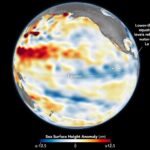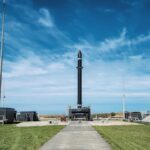Threats from space aren’t always obvious, but statistically, it’s only a matter of time before one of them happens. One of the most concerning for many space experts is a
phys.org16- Page
Below the waves of the Mediterranean, Europe’s KM3NeT neutrino telescope is on a cosmic hunt. Towering strings of sensors stretch a kilometer down to the seafloor, arranged in a vast
An international team of researchers has just revealed the existence of three Earth-sized planets in the binary stellar system TOI-2267 located about 190 light-years away. This discovery, published in Astronomy
Today’s ESA/Hubble Picture of the Week features a galaxy that Hubble has captured multiple times over more than 20 years. The galaxy is called NGC 3370, and it is a
No communication or navigation, faulty electronics and collision risk. At ESA’s mission control in Darmstadt, teams faced a scenario unlike any before: a solar storm of extreme magnitude. Fortunately, this
The origins of extremely high-energy particles that fill the universe—such as protons, electrons, and neutrinos—remain one of the longest-standing mysteries in modern astrophysics. A leading hypothesis suggests that “explosive transients,”
An international team of astronomers has created the first-ever large-scale maps of a mysterious form of matter, known as CO-dark molecular gas, in one of our Milky Way’s most active
A new dataset from the Green Bank Telescope (GBT) is now publicly available, opening the door for scientists worldwide to make discoveries in one of the richest molecular clouds in
From dew at dawn to a foggy mirror after a shower, condensation is part of our daily lives on Earth. In space, microgravity alters how heat flows through gases and
Using high-resolution data from the one-meter New Vacuum Solar Telescope (NVST), a research team led by Prof. Yan Xiaoli from the Yunnan Observatories of the Chinese Academy of Sciences (CAS)
-
 012024 in Review: Highlights from NASA in Silicon Valley
012024 in Review: Highlights from NASA in Silicon Valley -
 02Panasonic Leica Summilux DG 15mm f/1.7 ASPH review
02Panasonic Leica Summilux DG 15mm f/1.7 ASPH review -
 03From Polymerization-Enabled Folding and Assembly to Chemical Evolution: Key Processes for Emergence of Functional Polymers in the Origin of Life
03From Polymerization-Enabled Folding and Assembly to Chemical Evolution: Key Processes for Emergence of Functional Polymers in the Origin of Life -
 04How New NASA, India Earth Satellite NISAR Will See Earth
04How New NASA, India Earth Satellite NISAR Will See Earth -
 05And Thus Begins A New Year For Life On Earth
05And Thus Begins A New Year For Life On Earth -
 06Astronomy Activation Ambassadors: A New Era
06Astronomy Activation Ambassadors: A New Era -
07SpaceX launch surge helps set new global launch record in 2024





